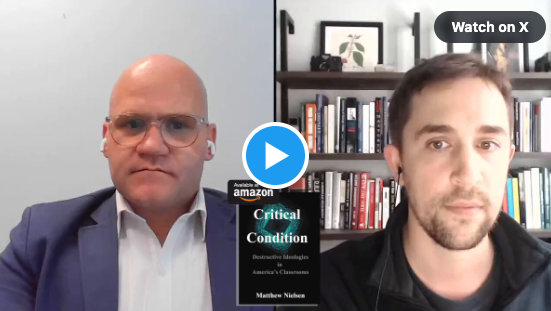Parents, politicians and unions are perpetually at odds over what to teach, how to teach and now, where to teach. Perhaps the time for real educational reform has arrived. It is time for ‘New School’. The following nine points lay out a path for educational reform that will enhance education and allow parents and students to flourish.
Imagine an educational system where teachers teach instead of discipline and where students learn without distraction. New School would allow parents and students to be free to decide what curriculum, teaching style and facility is best for their family.
New School would release millions of dollars into the market to be creatively invested in a wide variety of teaching platforms and teacher incentives attracting the best teachers to the industry. Competing schools will offer improved services which will result in better trained students. Schools will compete to get children into their school, working hard to convince child and parent alike that education is a good investment. Schools will spring up that cater to every interest, such as schools for those with physical or mental disabilities, those interested in STEM, those in poorer neighborhoods, those who wish to study the arts, people from different religions or of a different political stripe.
Some schools will teach controversial courses. Others will avoid these altogether. In the end, we would end up with a competition of ideas. The best ideas will win. The lesser ideas will go out of business. Poorly run schools, top heavy schools and unsafe schools will also go out of business. And no longer will parents be pitted against the ideological decisions of the school. If the parent doesn’t like the choices of the school, they can leave. And the school will have every incentive to provide what the parents want.
It will get police and CPS workers out of the truancy business and no longer will courts need to resolve disputes over speech, association, or religion as it relates to K-12 education.
The nine components are as follows:
Rescind Compulsory Attendance Laws
Roughly one half of inner-city male students will drop out before graduation. Of those that remain, 90% will fail to achieve proficiency in math and reading. Apparently compulsory attendance laws aren’t doing what we thought they were doing.
Compulsory attendance laws require teachers, the police and CPS workers to expend valuable resources forcing attendance and disciplining unruly students that are disruptive to those around them, jeopardizing the education of others.
If we rescind these laws, then only those that truly want an education will be in attendance. Teachers will just teach. Disruptive students will be expelled. Police, CPS workers and courts will do more productive activities.
Educational Debit Account (EDA)
Deliver all educational funding through debit accounts made available to every student. The account will distribute funding only to the school of the family’s choice, including public, private, parochial, charter, and trade school. Each EDA is funded by the state.
Replace Count Day with Test Day
Instead of rewarding schools for getting children to attend, we should reward schools for getting children to learn. Consequently, we should abandon count day. Instead we should test each student at the end of every school term. If the child can pass a basic exam covering the core curriculum, the school will receive the promised funding.
EDA Sharing
The number one indicator of student success is parental involvement. Therefore, we should allow parents to keep the difference between the cost of tuition and the value of the EDA. If there are thousands of dollars waiting at the end of the semester, the parent will have a financial motivation to make sure that his child is in attendance, studying, learning and passing.
Amend the Core Curriculum
The state’s interest is only that the student learn to read, write and do basic math. Any subject beyond that is the prerogative of the parent and student. Therefore, we should reduce the core curriculum to these three subjects. Every school will be required to teach at least these three subjects.
Non-Public
In addition to the core curriculum, all non-public schools should be free to teach whatever they think parents and students will purchase. Allow them complete autonomy to offer a limitless variety of classes, teaching methods, hours of instruction, and educational theories. Once funding is available, many different kinds of schools will start up, offering concentrations in any number of subjects. Parents and students will have a great array of options to choose from. And students will excel at subjects that they choose.
Public
All public schools will teach only the core curriculum providing a solid education in three essential subjects. They will have shorter days, lower overhead and will graduate their students earlier. Public school tuition will be capped at a level below the value of the EDA. Because of ‘EDA Sharing’ parents will have a financial incentive to be involved, giving their student’s a greater chance of success.
Eligibility
Any American citizen, regardless of age, should be eligible for an EDA to be used for K-12. Those that have dropped out should have the option to re-enroll. Admission of a student should be a voluntary agreement between student and school. Non-performing students can be expelled. Non-performing schools can be left for another school.
Teacher Accreditation
Eliminate teacher accreditation as a requirement for educational employment. Because the success of a school will depend upon its ability to deliver the education it promised, the school will screen teachers. Poor performing teachers will move into a different industry. Talented teachers will enter the profession even if they have no formal education in teaching. Professionals from other industries will cross into education offering their knowledge on their subject of expertise. Universities will begin to cater to the demand of the schools instead of schools having to hire only teachers that have adopted a uniform ideology. And the final reviewer of a teacher’s ability will be the parent and student who can always take their EDA to a different school.
The state’s only interest in education is to provide the funding for each student to learn to read, write and do basic mathematics. All other educational goals are not the business of the state. What a child learns is up to the student and the parent. Uniformity of thought is not a legitimate goal of the state. Neither is uniformity of religion. Leave the family the freedom to decide how to spend their EDA. They will usually make the best choices for their children.


